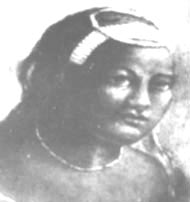ʻĀina ʻoluʻolu uluwehiwehi
ʻĀina piha ʻoe i ke aloha
A he wahi poina ʻole ʻia naʻu
Ke ku mau no a Kaʻuiki
A he puʻu kaulana no ka ʻāina
He aloha Kaʻuiki a e ku nei
Ke one hānau o Kaʻahumanu
Haʻina ka inoa a i lohe ʻia
ʻO Kaʻahumanu no e ō mai

Kaʻahumanu
Beautiful is Hana in my
sight
Land cool and lush
You are a land filled with
love
A place I`ll never
forget
There stands Kaʻuiki
A famous hill of the
land
Beloved is Kaʻuiki that stands
there
The birthplace of
Kaʻahumanu
Tell the name and let it be
heard
O Kaʻahumanu, do answer
Source: Hula Record Album: Auntie Alice
Kuʻuleialohapoinaʻole Nāmakelua - The composer was inspired
to write this mele September 14, 1973, to commemorate a visit
to Hana, birthplace of Kaʻahumanu, the favorite wife of
Kamehameha I. Kaʻahumanu, the high-spirited, strong-willed
and proud daughter of Keʻeaumoku and Namahana was born about 1768-73.
The infant,
Kaʻahumanu was
taken to
Heiau
Kaniomoku at Hana, after her birth in the cave at Puʻu Kaʻuiki. Her
father Keʻeaumoku was at that time, the defender of the paʻa kauʻa
(fortress) of Kaʻuiki. Described as a kind-hearted and obedient child,
the young athletic chiefess startled Kamehameha I with her beauty when
he saw her at the Makahiki
games. Determined to make her his wife, she consented only after he agreed
to name any of their children, as his primary heirs. In 1785, between
the of age 13-18, she married Kamehameha I, in a simple ceremony. He had
2 other
wives
before he married Kaʻahumanu, but she was his favorite. Unfortunately,
there was no issue from this marriage, but Kaʻahumanu raised Liholiho
(Kamehameha II), the son of her husband and Keopuolani, the sacred and
most high-ranking wife of Kamehameha I. George Vancouver, the explorer
and a dear friend of Kamehameha admired the affection between the couple
and
described
Kaʻahumanu, as one of
the finest women he had ever known. The death of Kamehameha I in 1819,
placed young Kalaninui Liholiho on the throne
as Kamehameha II, with Kaʻahumanu as the Kuhina Nui. She
was a good prime minister, diligent in her duties and loved the power.
In
this capacity, she started the systematic destruction of the Hawaiian religion
with Keopuolani, the sacred Queen. First, they broke the eating kapu for women,
then ordered the dismantling of heiaus and burning of the ancient gods. The battle
of Kuamoʻo, the last concerted effort to save the Hawaiian religion, ended in
defeat. The arrival of the Christian missionaries in 1820, filled the religious
void of the Hawaiians. Kaʻahumanu advised the king to allow them to stay and
teach. Intelligient and curious, the chiefess visited the missionaries
often, eager
to learn about life beyond her native land. When she became ill in 1821, the
missionaries, Mr. and Mrs. Bingham visited her every day and forged a friendship
that stirred Kaʻahumanu’s interest in Christianity. They taught her to
read and write and she became an advocate of education for the people. Upon the
death of Liholiho, his brother Kauikeaouli was declared king in 1825, at age
11. Kaʻahumanu was installed as kuhina nui/prime minister and ruled as
regent until her death. Returning from a tour of the windward islands, Kaʻahumanu
became ill. Servants carried the regent to her cottage in Mānoa Valley, pausing
at the fresh water spring at Punahou for refreshment, before continuing the 3
miles to her home. During her illness, translation of the New Testament was completed
and Mr. Bingham presented her with the first copy bound in red leather with her
name engraved in gold letters on the cover. She kept it with her until her death
of intestinal illness, June 5, 1832.